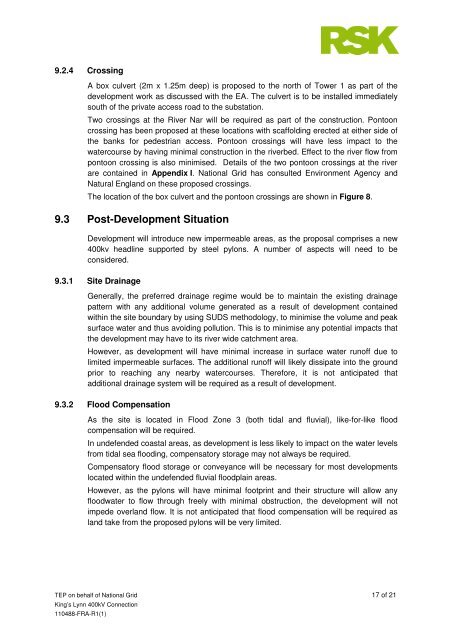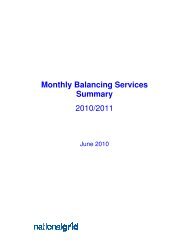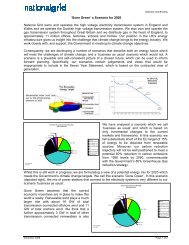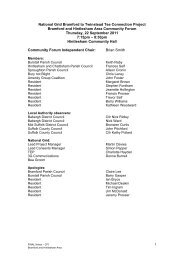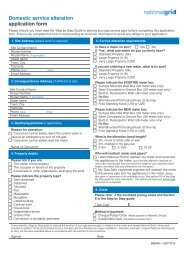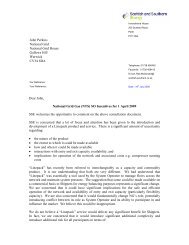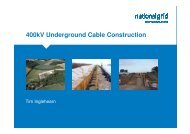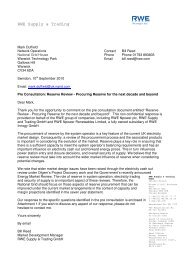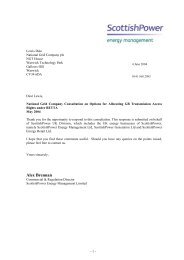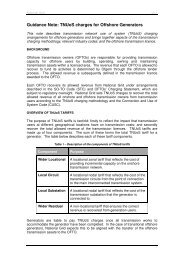appendix a - National Grid
appendix a - National Grid
appendix a - National Grid
You also want an ePaper? Increase the reach of your titles
YUMPU automatically turns print PDFs into web optimized ePapers that Google loves.
9.2.4 Crossing<br />
TEP on behalf of <strong>National</strong> <strong>Grid</strong> 17 of 21<br />
King’s Lynn 400kV Connection<br />
110488-FRA-R1(1)<br />
A box culvert (2m x 1.25m deep) is proposed to the north of Tower 1 as part of the<br />
development work as discussed with the EA. The culvert is to be installed immediately<br />
south of the private access road to the substation.<br />
Two crossings at the River Nar will be required as part of the construction. Pontoon<br />
crossing has been proposed at these locations with scaffolding erected at either side of<br />
the banks for pedestrian access. Pontoon crossings will have less impact to the<br />
watercourse by having minimal construction in the riverbed. Effect to the river flow from<br />
pontoon crossing is also minimised. Details of the two pontoon crossings at the river<br />
are contained in Appendix I. <strong>National</strong> <strong>Grid</strong> has consulted Environment Agency and<br />
Natural England on these proposed crossings.<br />
The location of the box culvert and the pontoon crossings are shown in Figure 8.<br />
9.3 Post-Development Situation<br />
Development will introduce new impermeable areas, as the proposal comprises a new<br />
400kv headline supported by steel pylons. A number of aspects will need to be<br />
considered.<br />
9.3.1 Site Drainage<br />
Generally, the preferred drainage regime would be to maintain the existing drainage<br />
pattern with any additional volume generated as a result of development contained<br />
within the site boundary by using SUDS methodology, to minimise the volume and peak<br />
surface water and thus avoiding pollution. This is to minimise any potential impacts that<br />
the development may have to its river wide catchment area.<br />
However, as development will have minimal increase in surface water runoff due to<br />
limited impermeable surfaces. The additional runoff will likely dissipate into the ground<br />
prior to reaching any nearby watercourses. Therefore, it is not anticipated that<br />
additional drainage system will be required as a result of development.<br />
9.3.2 Flood Compensation<br />
As the site is located in Flood Zone 3 (both tidal and fluvial), like-for-like flood<br />
compensation will be required.<br />
In undefended coastal areas, as development is less likely to impact on the water levels<br />
from tidal sea flooding, compensatory storage may not always be required.<br />
Compensatory flood storage or conveyance will be necessary for most developments<br />
located within the undefended fluvial floodplain areas.<br />
However, as the pylons will have minimal footprint and their structure will allow any<br />
floodwater to flow through freely with minimal obstruction, the development will not<br />
impede overland flow. It is not anticipated that flood compensation will be required as<br />
land take from the proposed pylons will be very limited.


